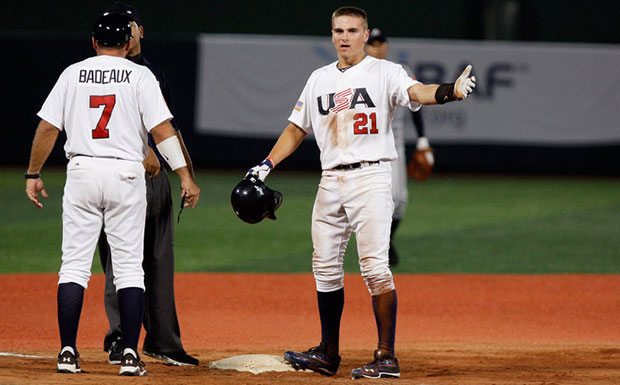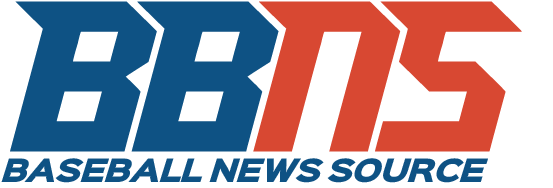 One of the most difficult positions on the diamond is often considered to be that of the catcher. Not only is a catcher expected to understand his pitchers, opposing hitters and their respective strengths and weaknesses, and endure the physical wear of crouching behind the plate for the duration of a game, but also make the time to focus on the mechanics of their own hitting.
One of the most difficult positions on the diamond is often considered to be that of the catcher. Not only is a catcher expected to understand his pitchers, opposing hitters and their respective strengths and weaknesses, and endure the physical wear of crouching behind the plate for the duration of a game, but also make the time to focus on the mechanics of their own hitting.
Due to such, being able to find a quality catching prospect is perhaps one of the hardest tasks that face clubs come draft day. Since catchers are relied upon primarily for the aforementioned tasks, offense is not typically valued as an imperative expectation.
Although there are no clear-cut star catching prospects in this year’s draft, a number of solid high school and college level prospects are projected to be strong draft day selections.
1. Reese McGuire, Kentwood HS (WA)
McGuire possesses the best defensive skills of all catchers in this year’s draft crop. McGuire has a cannon for an arm and great athletic ability behind the plate that includes premier blocking ability and maneuverability. He has a good, strong frame and has showcased the ability to drive the ball with power, but still remains raw in terms of offense, as he may need to develop the mechanics of his plate discipline. McGuire should project to be an everyday catcher in the future based upon his plus defensive ability, and could become an all-around star player if the right adjustments are made to his offensive game.
Draft Projection: Early to Mid First-Round
2. Stuart Turner, University of Mississippi
Although Turner is projected to be taken in the second round (or later), the Ole Miss backstop has been one of, if not the best catchers in college baseball this spring. Turner has been highly underrated by analysts and scouts this spring, as he has led the Ole Miss offense with a .381 batting average and 50 RBI in 59 games. He possesses a clean, easy swing and has excellent bat control, displaying maturity and poise in the batter’s box. Behind the plate, Turner has plus game management skills and a strong arm, but needs to work slightly on refining both is offensive and defensive mechanics. Turner should project to be an everyday catcher at the next level due to his intelligence of the game, and should be a huge steal come draft day.
Draft Projection: Second-Round
3. Jon Denney, Yukon HS (OK)
Denney has the most skilled bat of the catching crop, as he possesses great bat speed and fluid plate mechanics. He has strong wrists, which allows him to control the bat and drive the ball with raw power. In terms of defense, Denney still needs plenty of development. While he has a solid arm, he needs improvement in terms of maneuverability behind the plate and pitch adjustment. Given the event that he improves his defensive ability (or moves to first base), Denney should project to be a solid big league star with his strong offensive tools.
Draft Projection: Mid to Late First-Round
4. Nick Ciuffo, Lexington HS (SC)
Ciuffo is a strong offensive prospect, with solid pop and bat speed to go along with a good catcher’s build (6-1, 200). Ciuffo projects to hit for solid average as he makes really good contact and has strong plate discipline. In terms of receiving skills and arm strength, Ciuffo is one of the strongest catching prospects in this draft, but needs to refine those skills for better consistency. With proper development, Ciuffo should become an everyday starter with plus offensive ability and decent defensive tools.
Draft Projection: Mid to Late First-Round
5. Jeremy Martinez, Mater Dei HS (CA)
Martinez owns a smooth swing and solid pop, which gives him the projection to become a good power threat at the next level. He has solid receiving skills and decent arm strength, possessing the fundamentals necessary to become an everyday starting catcher for a future big league club. Martinez is a polished backstop and should move quickly throughout the minors. Although his stock has dwindled this spring with slightly inconsistent play, Martinez will be a steal for an interested club, as he will most likely fall to the second round.
Draft Projection: Second-Round
6. Chris Okey, Eustis HS (FL)
Although he does not project to hit for considerable power due to the fact that he swings primarily with his upper body, Okey has solid bat speed and contact that should allow him to hit for decent average at the next level. In terms of receiving skills and arm strength, Okey is solid in that he is athletic and fundamentally sound behind the backstop. Okey should be relied primarily on his defensive merit in the big leagues, where he will bring excellent fundamental skills to a club that needs a catcher that will go out and get the job done for the team.
Draft Projection: Supplemental First-Round
7. Andrew Knapp, University of California
Knapp has improved offensively this spring, but does not offer future offensive prowess, as he possesses average offensive tools. Although there are issues concerning his receiving skills (which can be refined with proper development, although such skills should not be below-average for a seasoned college catcher), Knapp has good upside in terms of defense as he has had experience catching advanced college pitching in three years at California. Knapp should project to be a decent catcher with backup/part-time level production.
Draft Projection: Second-Round
8. Zack Collins, American Heritage HS (FL)
Collins does not have the projection to become an everyday catcher, as a potential move to first base is highly likely, due to the fact that he has a rather weak arm and his core is slow when behind the plate. Despite his weaknesses as a backstop, Collins has received much praise for his offensive prowess. Collins has strong wrists, good bat speed, and a great eye, as well as a powerful uppercut swing that generates plus power. His strong frame (6-3, 220) will allow him to produce at the next level, whether behind the plate or at first base.
Draft Projection: Second-Round
9. Dom Nunez, Elk Grove HS (CA)
Nunez has a professional and polished approach to his game that can be attributed to his time on Team USA for the past two summers. Nunez has a smooth swing and can hit the ball to all fields relatively well, which should translate to success as a future average hitter. He needs plenty of development on his defensive game, particularly in regards to receiving skills and much of the basics, but should progress quickly with his experience and mature approach to the game. If given the opportunity by a patient club, Nunez could become a solid young catching prospect that may surprise many at the next level and leave clubs wishing they should have stolen him earlier.
Draft Projection: Second or Third-Round
10. Zane Evans, Georgia Institute of Technology
Evans has served as a two-way player for Georgia Tech for the past two seasons, spending time behind the plate and on the mound. Although he has a solid off-speed arsenal highlighted by good movement and fade, Evans is projected to succeed as a catcher at the next level. Evans has developing pop and plate discipline, and has good skills behind the plate, possessing good arm strength and an ability to receive (and block) good, advanced pitches. With proper development in the minors, Evans may have solid upside in the big leagues.
Draft Projection: Third-Round
